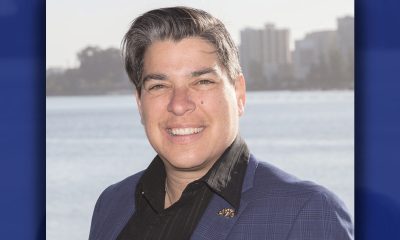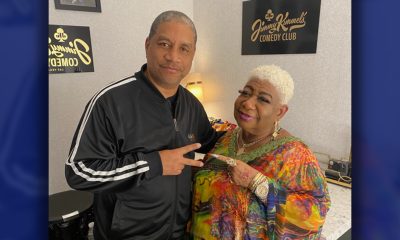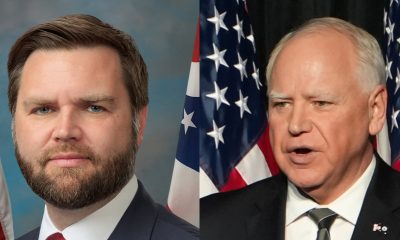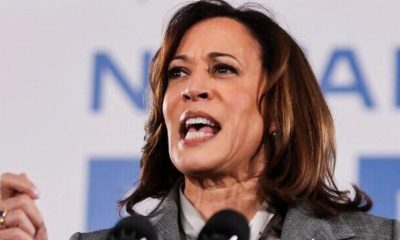#NNPA BlackPress
Norton’s Congressional Bill Ensures U.S. Government Includes Black and Women-Owned Media in Advertising Contracts
NNPA NEWSWIRE — “In 2017, the GAO examined spending on advertising contracts with minority-owned businesses by five agencies – the Department of Defense, the Department of the Treasury, the Department of Health and Human Services, the Department of the Interior, and the National Aeronautics and Space Administration – and found that only five percent of the $4.3 billion available for advertising contracts went to minority businesses,” said Congresswoman Eleanor Holmes Norton (D-DC).
By Stacy M. Brown, NNPA Newswire Correspondent
@StacyBrownMedia
BREAKING NEWS — Wednesday, May 8, 2019, Congresswoman Eleanor Holmes Norton (D-DC) formally introduces a bill that she and others hope will help to stop federal agencies from overlooking Black-, other minority-, and women-owned businesses when establishing advertising contracts.
The bill requires all federal agencies to include in their annual budget justifications for the amount spent on advertising contracts with Small Disadvantaged Businesses (SDBs) and businesses owned by Blacks, women and other minorities in the previous fiscal year.
The legislation, which is co-sponsored by California Democratic Congresswoman Barbara Lee and Wisconsin Democratic Congresswoman Gwen Moore, also requires that each agency provide projections of their spending for the upcoming fiscal year.
“The National Newspaper Publishers Association (NNPA) applauds and salutes the outstanding leadership of Congresswoman Norton for introducing one of the most important Congressional bills to potentially benefit the Black Press of America,” said NNPA President and CEO Dr. Benjamin F. Chavis, Jr.
“For too long, millions of annual federal advertising dollars have not been spent with Black-, other minority- and women-owned newspapers and media businesses,” Chavis said.
Chavis also thanked Representatives Barbara Lee (D-CA) and Gwen Moore (D-WI) for co-sponsoring “this game-changing legislation.”
“We further thank Congressional Black Caucus (CBC) Chair, Congresswoman Karen Bass (D-CA), and all the members of the CBC for their resolute support of the Black Press of America,” he said.
Norton and Lee also sent letters to all 12 House appropriations subcommittees requesting that they direct each agency under their jurisdiction to include the pertinent information in their fiscal year 2021 budget justifications.
An accompanying House fiscal year 2020 Labor-HHS-Education Appropriations bill – the first fiscal year 2020 report released thus far and the second largest appropriations bill – further directs the agencies to include data in their fiscal year 2021 budget justifications.
“As the largest advertiser in the United States, the federal government has an obligation to ensure fair access for minority and women-owned media companies,” said Norton, who earlier this month was ranked as the most effective House Democrat by the Center for Effective Lawmaking.
Led by professors at the University of Virginia and Vanderbilt University, the Center for Effective Lawmaking defines legislative effectiveness as the “proven ability to advance a member’s agenda items through the legislative process and into law.”
It’s that reason that Norton and the nation’s Black-, other minority- and women-owned media companies are optimistic that her proposed legislation will aid their businesses, which have long played a vital role in local communities.
“My bill would ensure that federal agencies are striving to reach minorities and women, who often get their news from outlets that serve more specific communities,” Norton said.
Lee added that it’s important that federal agencies comply.
She said that African American-, women-, and other minority-owned businesses should always have a seat at the table when it comes to government advertising and contracts.
In 2016, Norton led members of Congress in requesting a GAO report on their advertising contracts.
Released in July 2018, the GAO report showed that, in fiscal year 2017, only 16 percent of the federal government’s advertising contract obligations went to businesses owned by minorities and women.
“In 2017, the GAO examined spending on advertising contracts with minority-owned businesses by five agencies – the Department of Defense, the Department of the Treasury, the Department of Health and Human Services, the Department of the Interior, and the National Aeronautics and Space Administration – and found that only five percent of the $4.3 billion available for advertising contracts went to minority businesses,” Norton said.
“In light of these concerning figures, we, and several Members, sent a letter to the GAO in April 2016 requesting updated information on the amount of federal advertising dollars spent with SDBs and businesses owned by minorities and women,” she said.
“The GAO’s findings make it clear that there is still much progress to be made,” Norton said.
Further, she said the regular collection of information on federal advertising contracts with SDBs and businesses owned by women and minorities is essential to bridging the divide between current statistics and a more inclusive advertising landscape.
“Collection would also promote transparency and encourage federal agencies to strive to reach minorities, who often receive their daily news from smaller media outlets that serve communities of color,” Norton said.
“Collection of this information would also demonstrate that the promotion of equity in advertising, and in all areas of government, should be a continuous effort that is central to the mission of every agency,” she said.
#NNPA BlackPress
IN MEMORIAM: Beloved ‘Good Times’ Star and Emmy-Nominated Actor, John Amos, Dies at 84
NNPA NEWSWIRE — Amos’ acting career spanned over five decades, with his most iconic role being that of James Evans Sr., the no-nonsense, hard-working father on the groundbreaking CBS sitcom “Good Times” (1974–1979). The show, which was the first sitcom to center on an African American family, became a cultural touchstone, and Amos’ portrayal of James Evans Sr. made him a symbol of strength and dignity for countless viewers.

By Stacy M. Brown
NNPA Newswire Senior National Correspondent
John Amos, the Emmy-nominated actor and pioneering television star who brought to life some of the most beloved characters in entertainment history, has died. He was 84. His son, K.C. Amos, confirmed in a statement that Amos passed away more than a month ago, on Aug. 21, in Los Angeles of natural causes. The younger Amos didn’t say why he kept his father’s death under wraps for more than a month.
“It is with heartfelt sadness that I share with you that my father has transitioned,” K.C. said. “He was a man with the kindest heart and a heart of gold… and he was loved the world over. Many fans consider him their TV father. He lived a good life. His legacy will live on in his outstanding works in television and film as an actor.”
Amos’ acting career spanned over five decades, with his most iconic role being that of James Evans Sr., the no-nonsense, hard-working father on the groundbreaking CBS sitcom “Good Times” (1974–1979). The show, which was the first sitcom to center on an African American family, became a cultural touchstone, and Amos’ portrayal of James Evans Sr. made him a symbol of strength and dignity for countless viewers.
However, his time on the series was cut short after three seasons due to creative differences with the show’s producers. Amos famously clashed with the show’s direction, objecting to what he saw as the stereotypical portrayal of his on-screen son, J.J., played by Jimmie Walker.
“We had a number of differences,” Amos recalled in later interviews, according to the Hollywood Reporter. “I felt too much emphasis was being put on J.J. in his chicken hat, saying ‘Dy-no-mite!’ every third page.” Amos’ insistence on portraying a more balanced, positive image of the Black family on television led to his departure from the show in 1976, when his character was written out in a dramatic two-part episode.
Born John Allen Amos Jr. on Dec. 27, 1939, in Newark, New Jersey, Amos began his professional life with dreams of playing football. He played the sport at Colorado State University and had brief stints with teams like the Denver Broncos and Kansas City Chiefs. But after a series of injuries and cutbacks, Amos transitioned to entertainment, beginning his career as a writer and performer.
Amos got his first major acting break as Gordy Howard, the good-natured weatherman on “The Mary Tyler Moore Show,” appearing on the iconic series from 1970 to 1973. He would go on to write and perform sketches on “The Leslie Uggams Show” and later landed roles in various television series and films.
In 1977, Amos received an Emmy nomination for his powerful portrayal of the adult Kunta Kinte in the landmark ABC miniseries “Roots,” a role that solidified his status as one of television’s most respected actors. Amos’ performance in “Roots”, one of the most watched and culturally significant TV events of all time, remains one of his most enduring achievements.
In addition to his success on television, Amos made his mark in films. He appeared in Melvin Van Peebles’ groundbreaking blaxploitation film “Sweet Sweetback’s Baadasssss Song” (1971) and “The World’s Greatest Athlete” (1973). He was widely recognized for his role in “Coming to America” (1988), where he played Cleo McDowell, the owner of McDowell’s, a fast-food restaurant parody of McDonald’s. Amos reprised the role over three decades later in “Coming to America 2” (2021).
His filmography also includes the Sidney Poitier and Bill Cosby classic “Let’s Do It Again” (1975), “The Beastmaster” (1982), “Die Hard 2” (1990), “Ricochet” (1991), “Mac” (1992), “For Better or Worse” (1995), “The Players Club” (1998), “Night Trap” (1993), and “Because of Charley” (2021).
Amos was also a familiar face on television throughout the 1980s, 1990s, and 2000s, with recurring roles in shows like “The West Wing” as Admiral Percy Fitzwallace, chairman of the Joint Chiefs of Staff, and “The Fresh Prince of Bel-Air” as Will Smith’s stepfather. He appeared in “The District,” “Men in Trees,” “All About the Andersons” (as Anthony Anderson’s father), and the Netflix series “The Ranch.”
Beyond acting, Amos had a passion for writing and performing in theater. In the 1990s, when he found it challenging to secure roles in Hollywood, he wrote and starred in the one-person play “Halley’s Comet,” about an 87-year-old man waiting in the woods for the comet’s arrival. He toured with the production for over 20 years, performing in cities across the United States and abroad.
In addition to his onscreen and stage accomplishments, Amos co-produced the documentary “America’s Dad,” which explored his life and career. He was also involved in Broadway, appearing in Carl Reiner’s “Tough to Get Help” production in 1972.
John Amos’ life and career were not without personal challenges. In recent years, he was embroiled in a public legal battle between his children, K.C. and Shannon, over accusations of elder abuse.
This unfortunate chapter cast a shadow over his later years. However, his legacy as a beloved television father and one of Hollywood’s pioneering Black actors remains untarnished.
Both K.C. and Shannon, children from his first marriage to artist Noel “Noni” Mickelson and his ex-wife, actress Lillian Lehman, survive Amos.

Photo of the Evans family from the television program “Good Times.” From left: Ralph Carter (Michael), BernNadette Stanis (Thelma), Jimmie Walker (J.J.), Esther Rolle (Florida), John Amos (James).
#NNPA BlackPress
Reading and Moving: Great Ways to Help Children Grow
NNPA NEWSWIRE — In these formative years, your little one will learn to walk, learn how to grab and hold items, begin building their muscle strength, and more. Here are some ways to facilitate positive motor development at home:

Council for Professional Recognition
Before a child even steps into a classroom or childcare center, their first life lessons occur within the walls of their home. During their formative years, from birth to age five, children undergo significant cognitive, motor, and behavioral development. As their primary guides and first teachers, parents, and guardians play a pivotal role in fostering these crucial aspects of growth.
The Council for Professional Recognition, a nonprofit, is dedicated to supporting parents and families in navigating questions about childcare and education training. In keeping with its goal of meeting the growing need for qualified early childcare and education staff, the Council administers the Child Development Associate (CDA). The CDA program is designed to assess and credential early childhood education professionals. This work gives the Council great insights into child development.
Cognitive Development: Building the Foundation of Learning
Cognitive development lays the groundwork for a child’s ability to learn, think, reason, and solve problems.
- Read Together: One of the most powerful tools for cognitive development is reading. It introduces children to language, expands their vocabulary, and sparks imagination. Make reading a daily ritual by choosing age-appropriate books that capture their interest.
- Play Together: Play is a child’s entry to the physical, social, and affective worlds. It’s a critical and necessary tool in the positive cognitive development of young children and is directly linked to long-term academic success.
- Dance and Sing Together: These types of activities help young children develop spatial awareness and lead to improved communication skills. As a bonus, it’s also helpful for improving gross motor skills.
- Invite your Child to Help you in the Kitchen: It’s a fun activity to do together and helps establish a basic understanding of math and lifelong healthy eating practices.
- Encourage Questions: As children find their voice, they also find their curiosity for the world around them; persuade them to ask questions and then patiently provide answers.
Motor Development: Mastering Movement Skills
Motor development involves the refinement of both gross and fine motor skills, which are essential for physical coordination and independence. In these formative years, your little one will learn to walk, learn how to grab and hold items, begin building their muscle strength, and more. Here are some ways to facilitate positive motor development at home:
- Tummy Time: Starting from infancy, incorporate daily tummy time sessions to strengthen neck and upper body muscles, promoting eventual crawling and walking. You can elevate the tummy time experience by:
- Giving children lots of open-ended toys to explore like nesting bowls, a pail and shovel, building blocks, wooden animals, and people figures.
- Hanging artwork on the wall that appeals to infants, including bold colors, clear designs, and art from various cultures.
- Providing mobiles that children can move safely and observe shapes and colors.
- Outdoor Play: Provide opportunities for outdoor play, whether it’s at a park, playground, or in a backyard. Activities such as running, jumping, climbing, and swinging enhance gross motor skills while allowing children to connect with nature. Also, try gardening together! Not only does gardening promote motor skill development, but it offers many other benefits for young children including stress management, cognitive and emotional development, sensory development, and increased interest in math, sciences, and healthy eating.
- Fine Motor Activities: Fine motor skills relate to movement of the hands and upper body, as well as vision. Activities that encourage hand-eye coordination and fine motor skill development include:
- Drawing and coloring
- Doing puzzles, with size and piece amounts dependent on the age of the child
- Dropping items or threading age-appropriate beads on strings
- Stacking toys
- Shaking maracas
- Using age-appropriate, blunt scissors
- Playing with puppets or playdough
This is the type of knowledge that early childhood educators who’ve earned a Child Development Associate credential exhibit as they foster the social, emotional, physical, and cognitive growth of young children.
Supporting Early Childhood Educators
Recently, a decision in Delaware has helped early childhood professionals further their efforts to apply this type of knowledge. Delaware State University, Delaware Technical Community College, and Wilmington University have signed agreements to award 12 credits for current and incoming students who hold the Child Development Associate credential.
Delaware Governor John Carney said, “I applaud the Department of Education and our higher education partners for this agreement, which will support our early childhood educators. Research shows how important early childhood education is to a child’s future success. This new agreement will help individuals earn their degrees and more quickly get into classrooms to do the important work of teaching our youngest learners in Delaware.”
Council for Professional Recognition CEO Calvin E. Moore, Jr., said his organization is honored to be a part of this partnership.
“Delaware and the work of these institutions is a model that other states should look to. This initiative strengthens the early childhood education workforce by accelerating the graduation of more credentialed educators, addressing the critical need for qualified educators in early childhood education. We have already seen the impact the work of the Early Childhood Innovation Center has brought to the children of Delaware.”
#NNPA BlackPress
Student Loan Debt Drops $10 Billion Due to Biden Administration Forgiveness
NNPA NEWSWIRE — The Center for American Progress estimates the interest waiver provisions would deliver relief to roughly 6 million Black borrowers, or 23 percent of the estimated number of borrowers receiving relief, as well as 4 million Hispanic or Latino borrowers (16 percent) and 13.5 million white borrowers (53 percent).

New Education Department Rules hold hope for 30 million more borrowers
By Charlene Crowell, The Center for Responsible Lending
As consumers struggle to cope with mounting debt, a new economic report from the Federal Reserve Bank of New York includes an unprecedented glimmer of hope. Although debt for mortgages, credit cards, auto loans and more increased by billions of dollars in the second quarter of 2024, student loan debt decreased by $10 billion.
According to the New York Fed, borrowers ages 40-49 and ages 18-29 benefitted the most from the reduction in student loan debt.
In a separate and recent independent finding, 57 percent of Black Americans hold more than $25,000 in student loan debt compared to 47 percent of Americans overall, according to The Motley Fool’s analysis of student debt by geography, age and race. Black women have an average of $41,466 in undergraduate student loan debt one year after graduation, more than any other group and $10,000 more than men.
This same analysis found that Washington, DC residents carried the highest average federal student loan debt balance, with $54,146 outstanding per borrower. Americans holding high levels of student debt lived in many of the nation’s most populous states – including California, Texas, and Florida.
The Fed’s recent finding may be connected to actions taken by the Biden administration to rein in unsustainable debt held by people who sought higher education as a way to secure a better quality of life. This decline is even more noteworthy in light of a series of legal roadblocks to loan forgiveness. In response to these legal challenges, the Education Department on August 1 began emailing all borrowers of an approaching August 30 deadline to contact their loan servicer to decline future financial relief. Borrowers preferring to be considered for future relief proposed by pending departmental regulations should not respond.
If approved as drafted, the new rules would benefit over 30 million borrowers, including those who have already been approved for debt cancellation over the past three years.
“These latest steps will mark the next milestone in our efforts to help millions of borrowers who’ve been buried under a mountain of student loan interest, or who took on debt to pay for college programs that left them worse off financially, those who have been paying their loans for twenty or more years, and many others,” said U.S. Secretary of Education Miguel Cardona.
The draft rules would benefit borrowers with either partial or full forgiveness in the following categories:
- Borrowers who owe more now than they did at the start of repayment. This category is expected to largely benefit nearly 23 million borrowers, the majority of whom are Pell Grant recipients.
- Borrowers who have been in repayment for decades. Borrowers of both undergraduate and graduate loans who began repayment on or before July 1, 2000 would qualify for relief in this category.
- Borrowers who are otherwise eligible for loan forgiveness but have not yet applied. If a borrower hasn’t successfully enrolled in an income-driven repayment (IDR) plan but would be eligible for immediate forgiveness, they would be eligible for relief. Borrowers who would be eligible for closed school discharge or other types of forgiveness opportunities but haven’t successfully applied would also be eligible for this relief.
- Borrowers who enrolled in low-financial value programs. If a borrower attended an institution that failed to provide sufficient financial value, or that failed one of the Department’s accountability standards for institutions, those borrowers would also be eligible for debt relief.
Most importantly, if the rules become approved as drafted, no related application or actions would be required from eligible borrowers — so long as they did not opt out of the relief by the August 30 deadline.
“The regulations would deliver on unfulfilled promises made by the federal government to student loan borrowers over decades and offer remedies for a dysfunctional system that has often created a financial burden, rather than economic mobility, for student borrowers pursuing a better future,” stated the Center for American Progress in an August 7 web article. “Meanwhile, the Biden-Harris administration also introduced income limits and caps on relief to ensure the borrowers who can afford to pay the full amount of their debts do so.”
“The Center for American Progress estimates the interest waiver provisions would deliver relief to roughly 6 million Black borrowers, or 23 percent of the estimated number of borrowers receiving relief, as well as 4 million Hispanic or Latino borrowers (16 percent) and 13.5 million white borrowers (53 percent).”
These pending regulations would further expand the $168.5 billion in financial relief that the Biden Administration has already provided to borrowers:
- $69.2 billion for 946,000 borrowers through fixes to Public Service Loan Forgiveness (PSLF).
- $51 billion for more than 1 million borrowers through administrative adjustments to IDR payment counts. These adjustments have brought borrowers closer to forgiveness and addressed longstanding concerns with the misuse of forbearance by loan servicers.
- $28.7 billion for more than 1.6 million borrowers who were cheated by their schools, saw their institutions precipitously close, or are covered by related court settlements.
- $14.1 billion for more than 548,000 borrowers with a total and permanent disability.
- $5.5 billion for 414,000 borrowers through the SAVE Plan.
More information for borrowers about this debt relief is available at StudentAid.gov/debt-relief.
Charlene Crowell is a senior fellow with the Center for Responsible Lending. She can be reached at Charlene.crowell@responsiblelending.org.
-

 Alameda County5 days ago
Alameda County5 days agoAlameda County District Attorney Pamela Price Announces $7.5 Million Settlement Agreement with Walmart
-

 Activism3 weeks ago
Activism3 weeks agoCOMMENTARY: DA Price Has Done Nothing Wrong; Oppose Her Recall
-

 Activism2 weeks ago
Activism2 weeks agoOP-ED: Hydrogen’s Promise a Path to Cleaner Air and Jobs for Oakland
-

 Activism3 weeks ago
Activism3 weeks agoBarbara Lee, Other Leaders, Urge Voters to Say ‘No’ to Recalls of D.A. Pamela Price, Mayor Sheng Thao
-

 Activism3 weeks ago
Activism3 weeks agoOakland Post: Week of October 9 – 15, 2024
-

 Community2 weeks ago
Community2 weeks agoTerry T. Backs Oakland Comedy Residency by Oakland’s Luenell at Jimmy Kimmel’s Comedy Club in Las Vegas
-

 Business2 weeks ago
Business2 weeks agoStudy Confirms California’s $20/Hour Fast Food Wage Raises Pay Without Job Losses
-

 Activism3 weeks ago
Activism3 weeks agoSurge of Support for Vote ‘No’ on Recall of Mayor Sheng Thao
































































